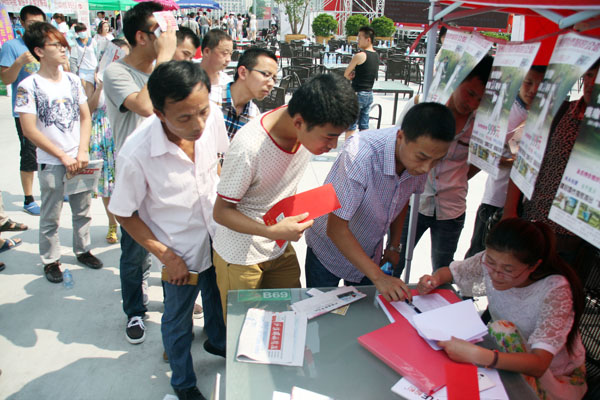 |
| Young men apply for a matchmaking program in Binzhou, Shandong province, on Aug 2. China will continue to experience a gender imbalance with more single men than women. [Guo Zhihua / For China Daily] |
JINAN - China's gender imbalance issue is back in the spotlight, after pregnant villagers in east China were alleged to be illegally determining the sex of their unborn children.
Lian Fang, a political advisor in Shandong Province, said this week that doctors in Shandong's rural areas have been surreptitiously purchasing B ultrasound machines and hiding them in villagers' back rooms.
Once the equipment is used to ascertain fetal gender, unborn boys are usually kept while unborn girls are typically aborted, Lian said at Shandong's "two sessions": the annual meetings of the province's legislature and provincial political advisory body.
Preference for boys is not uncommon in China, particularly in the countryside, where thousands of years of feudal values are still casting a shadow over people's attitudes.
China launched its one-child policy in the 1970s to curb soaring population growth. Many couples choose boys over girls in the belief that males could better support their families as well as carry on the family line and inherit property, as is required in feudal values.
And there seems to be little change in the mindset, even in the modern era. In Shandong, for instance, the sex ratio among newborns in 2013 was 116.6 to 100. This made 2013 the fourth consecutive year in which the ratio had narrowed in Shandong, but it is still "relatively high," Lian said at the two sessions, which will run until Sunday.
Guo Shuqing, the provincial governor, said on Tuesday that the male to female proportion had exceeded 120 to 100 in some parts of Shandong.
There has been heated discussion about the problem at the meetings, with political advisors seeking a solution.
Local authorities are apparently taking action, with an official plan to ease the quandary already included in Shandong's 2015 government work report.
Shandong's situation, however, only forms part of a bigger national problem.
Figures from the National Bureau of Statistics show that, as of the end of 2014, the Chinese mainland held 33.76 million more males than females, with the sex ratio standing at 115.88 to 100. Though that is a six-year decrease, it still stands high above the international standard, making China one of the world's most imbalanced countries in terms of sex structure.
